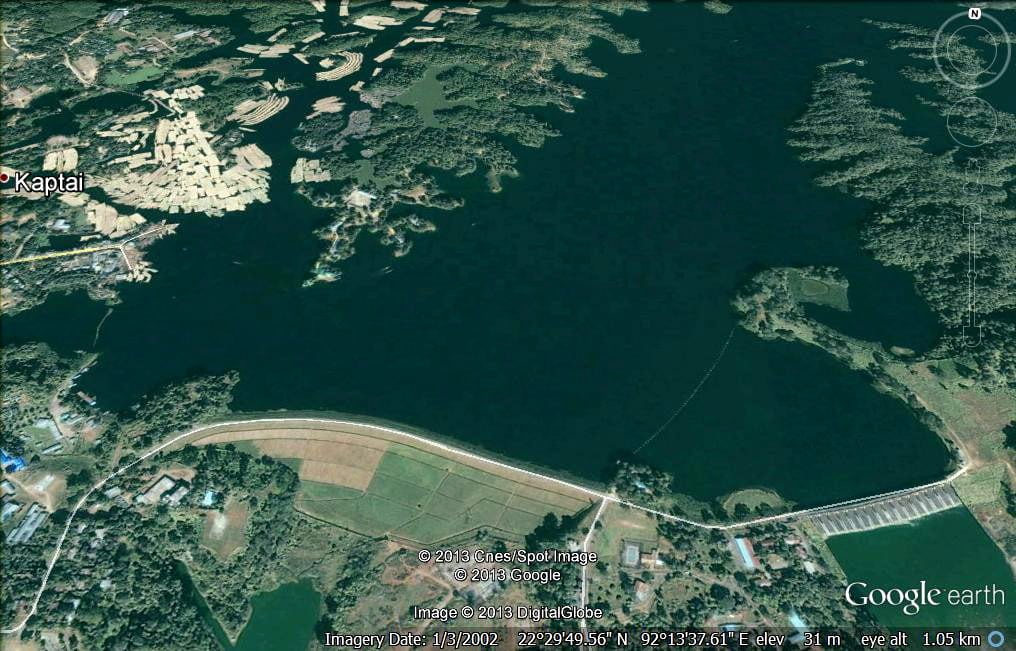Kaptai Dam and Indigenous Jumma peoples in CHT, Bangladesh
- – Mangal Kumar Chakma
The Chittagong Hill Tracts (CHT), south-eastern part of Bangladesh, comprises a total area of 5,093 sq. miles with over 1.325 million populations (0.700 million indigenous people and 0.625 million Bengali Muslim settlers). From time immemorial the CHT had been the home to at least eleven indigenous ethnic peoples’ groups who speak in different languages of their own. They collectively identify themselves as the Jumma people (High Landers) ? the first people of the CHT.
In 1960, Pakistan government built the Kaptai hydroelectric dam across the Karnafuli river in the heartland of the indigenous Jumma peoples in order to materialize its evil design and breaking down the economic backbone of the peoples of Chittagong Hill Tracts (CHT) and in the name of so-called industrial development. It flooded 1,036 square kilometers of lands and submerged 54% (54,000 acres) of the best arable land and also displaced about 100,000 Jumma people from their ancestral hearth and homes for good. The Rehabilitation Program undertaken by Pakistan authority proved to have been a cruel farce.
About 666 meters long and about 43 meters high, the dam was completed in six years. It resulted in a colossal artificial lake over an area of about 655 square kilometers. It swallowed 125 Mauzas including the major portion of Rangamati town. The former residents of the area claim that they watched helplessly as their lands and houses being engulfed by the surging water.
By Kaptai dam, indigenous Jumma peoples became panicky and because of insecurity, finding no other alternatives, from among them some 40,000 Chakma people obliged to migrate to India and about 20,000 other Jumma community peoples had to take refuge to Myanmar. The refugee people who were settled in Indian State of Arunachal are yet to be awarded with citizenship. The area affected by the Karnafuli project may be called as the nucleus of CHT.

American Master Plan allotted $ 60 millions for full comprehensive economic rehabilitation of evictees of the Kaptai Dam. In a publication of the Far Eastern Economic Review in 1980, it was amply stated that the government set $ 31 millions aside for rehabilitation. Only $ 2.6 millions had actually been spent for the purpose.
The Kaptai dam damaged the agro-based main economy of the CHT and brought about a permanent disintegration of the Jumma people on one hand and led to the inroads on Bengali Muslim population in the region in large number on the other. It created jobs and business opportunities for Bengali Muslim. The uprooted Jumma peoples were neither compensated properly for their lands and homesteads nor provided lands for their rehabilitation. It destroyed the economical backbone of the indigenous Jumma peoples completely. A vast reservoir of some 550 square miles came into being which inundated most of the fertile Karnafuli valley and large parts of Chengi, Kassalong and Maini valleys containing lush paddy fields and vegetable gardens.
Manabendra Narayan Larma, the champion of national awakening of indigenous Jumma peoples in CHT, a student leader in the early sixties and President and founder of the Parbatya Chattagram Jana Samhati Samiti (PCJSS) (The United Peoples’ Party) had to undergo detention in the jail for protesting against the unjustified and improper compensation and rehabilitation of the affected people of Kaptai dam by the government of Pakistan on 10 February 1963. He was released from detention on 8 March 1965.
A large number of frustrated Jumma farmers migrated to India where they still remain as stateless refugees. Of those who stayed back were both plough cultivators and Jum (shifting cultivation) cultivators the majority of which were forced back to Jum cultivation, although a significant number of them later took up horticulture. For the plough cultivators, this enforced changing from sedentary-plough cultivation to the traditional Jum cultivation was quite ironical because the government had been trying for many years to discourse the Jumma peoples from continuing with Jum cultivation in lieu of other modes of livelihood, or at least, that was the stated policy, and now it was the government itself which compelled the Jumma peoples to become Jumias again! Up till this day, a large number of the displaced peoples have neither been adequately compensated nor had been properly rehabilitated.
In 1964, government of Pakistan engaged a Canadian company called Forrestal Forestry and Engineering International Limited (Forestall in short) to survey the soil and topography of the land surface of the CHT. According to the Forrestal recommendation, government of Pakistan started the Chittagong Hill Tracts Horticulture Development Project in late 1960s to encourage fruit gardening. Bereft of their paddy fields, thousands of Jumma people enthusiastically took up horticulture. As far as the gardens were concerned, the growers were initially successful, but due to bad communications, marketing problems and lack of credit and storage facilities (including canning), fruit gardening began declining since the seventies and only since the late eighties there has been a slight slowing of this declination.
Aside from the immediate ecological damages such as inundating croplands, villages and forest, the Kaptai hydroelectric dam and the large lake that it created had far-reaching ecological effects. Because the reservoir inundated many of the best forested valleys, most of the wildlife once comprised of bison, sambur, barking deer, leopard, Royal Bengal Tiger, panther, etc. are not seen anymore. In less than forty years after construction of the Kaptai dam the tiger species have gone totally extinct from the CHT. Elephant population has drastically decreased. Although the CHT is still charming to the tourists, many now term it as a hilly park devoid of any significant wildlife. Water pollution in the Kaptai Lake has become seriously hazardous. Most of the people living around the Kaptai Lake depend on the lake water for bathing, washing, cooking and drinking. Human excreta and residue of pesticides and fertilizers, which make their way into the lake every day, pose health risks. Water pollution has also severely affected the life in the water.
The affected indigenous Jumma peoples had no role in the planning process nor were they consulted about the relocation or rehabilitation programme. They only had one choice and that was to leave the areas to be submerged. The people had completed an option from without any knowledge as most of them were unlettered. For many, the advice of a traditional leader like the Headman (mauza head) or a Karbari (village head) was considered to be important and in some cases these leaders took opposing positions. Very few were lucky enough to get advice from government officials. But the concept of any group decisions was absent and the government could have absolved of some responsibility, as rehabilitation concepts of today were not available by then.
The Kaptai hydroelectric dam is one of hundreds of development projects across the globe where people have been victimized without any proper compensation. Water projects have created lots of problem throughout the world. The projects which were initiated in CHT in the sixties and were financed by the United States have gone against the interest of the indigenous Jumma peoples. Over the past years, some people have taken hit even the headlines of the newspapers. But not enough corrective measures have been taken so far.
It is mentionable that an 18-member Karnafuli Lake Management Committee has been functioning for management of the Kaptai Lake in which divisional commissioner of Chittagong division was the chairman of the committee and only 4 public representatives were included in the committee as members. Other members were civil and military officials. The CHT Regional Council proposed to appoint CHTRC chairman as chairman and more public representatives as members of Karnafuli Lake Management Committee. But the ministry did not accept the proposal of the CHTRC. It is mentionable that the management of lakes is actively involved in the interest of the Jumma peoples living in the lake areas. They have been cultivating fringe lands of Kaptai Lake.
On the other, though the government officials promised to the Jumma peoples during construction of the dam that Jumma people would be provided job in the project and supplied with free electricity. But it is unfortunate that neither jobs nor free electricity have been provided to the Jumma peoples. Though it has passed 45 years after construction of Kaptai hydroelectric dam, the villages of Jumma peoples are still far away from electrification. Even the fishing in the lake area is under control of the Bengali outsiders.
It is not therefore difficult to believe that dissatisfaction with the Kaptai Dam and its aftermath was one of the major causes behind the present unrest in the CHT.

